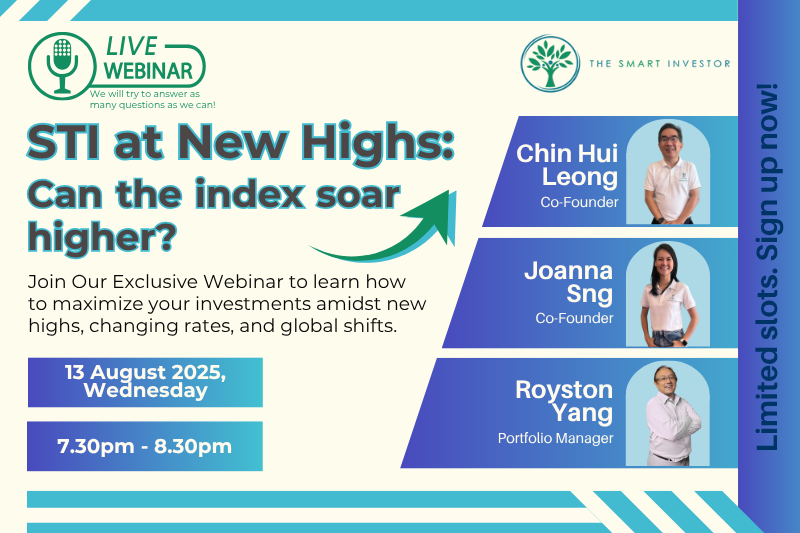Nothing in life is completely risk free.
But without taking some risks, you lose the opportunity to reap the rewards.
Even staying in your comfort zone is a risk in itself, for fear of the unknown would hold you back from achieving your financial goals.
This notion of risk versus reward lies at the core of investing.
Whether you are a beginner or a veteran investor, measuring risk versus reward is crucial, and you can’t have one without the other.
Let’s break down what it means to weigh the risks versus rewards.
What Risk Means in Investing
Before investing in stocks, you should take note of the potential risks that may arise.
These risks are broadly categorised into the following:
- Market risk – fluctuations in share prices due to economic headwinds or poor financial performance of the company
- Inflation risk – rising costs that impact returns over time
- Foreign exchange risk – volatility in currency exchange rates may thin profit margins
- Liquidity risk – some assets are more liquid than others. Stocks are liquid as you can sell them at any time. Investment-linked insurance products have a lock-in period, and you will incur a penalty if you decide to cancel the policy.
- Default risk – there is a chance that the company you have invested in may go belly up. Unable to pay off their loans, the company may be forced into liquidation by their creditors.
Here is a simple illustration of risk versus reward: Putting your money into a low-interest savings account may be the safest choice for you – it has high liquidity, which means you can withdraw the funds any time.
Your savings will be spared from market volatility too.
But with interest rates as low as 0.05% in savings accounts, you are at risk of having your cash savings eroded by core inflation, which has averaged 2.36% over the last five years.
On the other hand, if you invest in stocks, you will be exposed to a moderate amount of risk and market volatility, but annual historical returns are about 8.3% for Singapore’s Straits Times Index (SGX: ^STI) over the past decade.
These are sufficient returns to combat a higher cost of living.
What Does Reward Mean in Investing
Reward refers to financial gains or profit from an investment. It can be in the form of the following:
- Capital gains, which are the price appreciation of your investment, such as rising share prices
- Dividends, which are a portion of company profit distributed to shareholders. Similarly, Real Estate Investment Trusts (REITs) offer a distribution per unit.
- Interest income from fixed deposits, which offer guaranteed annual returns over a tenure
Your choice of investment will depend on your financial goals and needs.
For instance, if you are looking for a regular cash payout, you could invest in a REIT or a stock that distributes dividends.
Singapore Airlines (SGX: C6L) is an example of a dividend stock well-loved among Singaporeans.
The airline paid out a dividend of S$0.40 over the past 12 months, giving shares a trailing dividend yield of 6.1% based on a share price of S$6.54.
For capital gains, tech firms such as NVIDIA (NASDAQ: NVDA) and Netflix (NASDAQ: NFLX) are examples of growth stocks, known for their innovative products and their strong market positions to leverage long-term trends.
Companies that focus on growth could be worth holding on to but investors need to sell the stock in order to realise capital gains.
If you prefer a regular dividend payout that also acts as a hedge for risk then dividend stocks are for you.
The Risk-Reward Trade-Off
When it comes to investing, the general rule is the riskier the asset, the bigger the payoff.
A high-risk investment such as cryptocurrency is extremely volatile, and the unpredictable movements have left many traders incurring heavy losses on their bets.
On the other end, government bonds offer the lowest risk, but its annual yields range from 1.5% to 2%.
While it is indeed a safe bet, its returns are likely too low to mitigate the risk of inflation.
Medium risk assets such as blue-chip stocks offer capital gains, with some of them paying dividends regularly.
Investors need to research the company’s fundamentals and business strategy – are they robust enough to weather market volatility, slower demand, and economic downturns?
In essence, there is no such thing as a free lunch when it comes to investing.
Each investment comes with its own set of trade-offs that investors should take note of.
How to Balance Risk and Reward
Beginners should consider the following key points before starting their investment journey:
- What is your investment horizon?
- Are you looking to build a nest egg over the next 30 years, or are you saving to buy your first home in the next 10 years? The length of time matters, as it will influence the type of financial product you will purchase.
- What is your risk appetite?
- Are you approaching your retirement years, and are looking for a lower-risk option to protect your life savings?
- Or are you in your early 20s and have just entered the workforce, and are looking to invest in a growth portfolio to fund your dream home by the time you hit 30?
- What diversification are you looking for?
- Diversifying is a good way to mitigate risk, but will your portfolio lean towards a low or medium risk appetite?
- What sort of asset allocation fits into your investment horizon?
Beginners should be practical and start by investing a small amount of your paycheck in something lower-to-medium risk.
You can include riskier assets in your portfolio as your knowledge and confidence in investing grows.
Avoid these beginner mistakes
Don’t be fooled into thinking that investing will make you rich overnight.
Instead, think of it as a vehicle to help you reach your long-term financial goals.
Let your returns compound and do not let emotions sway you into making dangerous decisions!
- Do not chase high returns without understanding risk – just because your friend has bought into a high risk asset doesn’t mean you have to.
- Do your homework and invest only if you understand the risks involved.
- Do not panic sell – markets rise and fall daily.
- Be prudent and hold on to your investments over the long-term. Leverage the power of compounding to build up your finances.
- Do not ignore diversification – don’t just park all your money into a particular investment.
- If the company goes bust, there goes all your hard-earned cash. Instead, diversify your investments to manage risk.
- Do not invest money that you need into risky assets – your daily expenses and rent money should not be used for high risk investments. You need to eat and a roof over your head, so be practical and keep that cash in the bank.
Get Smart: Risk and Reward
Weighing risk versus reward is a critical lesson in financial wisdom, especially for beginners.
No investment is perfect and there is always a possibility of less-than-ideal outcomes. Take responsibility for your financial health by assessing your goals and risk appetite before making a decision.
Investing smartly involves managing risks and making calculated choices so you could reap the rewards and get closer to your financial goals.
The world’s gotten unpredictable, but some Singapore companies have quietly kept thriving. You’ve probably seen them in your daily life. And yes, they’ve kept paying dividends through it all. Meet 5 resilient stocks built to navigate global storms. Get the free report here and see how they’ve done it.
Follow us on Facebook, Instagram and Telegram for the latest investing news and analyses!
Disclosure: Jo-Ann does not own any of the stocks mentioned above.






